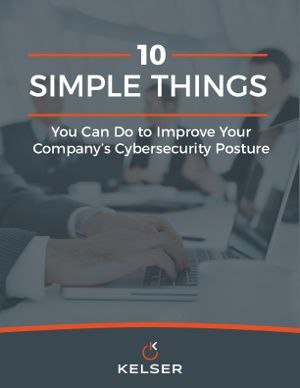Kelser Blog, Media, and News
All the latest Kelser news, media appearances, event recaps, press releases, and articles covering topics such as cybersecurity, business continuity, disaster recovery, networking and managed services, in one convenient place.
IT Lifecycle Management | Business Continuity
By:
Jim Parise
June 03, 2022
As a business leader, you have a lot on your mind. Finances, staffing, deliverables, sales, and more. At least your IT infrastructure is working. One less thing to think about, right? Well…maybe, but maybe not.
Cybersecurity | IT Lifecycle Management | IT Support
By:
Patty Luxton
September 15, 2021
When a firewall is working, it’s the last thing on your mind. But, did you know that most firewalls have a lifespan of three to five years?

Start improving your cybersecurity posture now with this ebook, free when you subscribe to our blog.
By:
Jim Parise
July 15, 2021
You’ve likely heard about or experienced the effects of the global supply chain disruption that we’re living through.
IT Lifecycle Management | Executive Consulting | Working with Kelser
By:
Matt Hoskin
May 11, 2021
You’ve consulted with an IT firm or managed service provider (MSP) and decided that a technology refresh could help your business. Your old Windows 7 workstations are limping along anyway and were creating security concerns on top of that. By switching from desktops to laptops you’re also meeting the needs of your more mobile workforce. But what now? You’re staring down a 30-workstation hardware refresh all at once. You already know that it’s a valuable and worthwhile investment. You’re just not sure what your options are for funding this IT purchase. You’re not alone in having these kinds of thoughts at this moment. Across my nearly two decades in finance and as Kelser’s vice president of finance, I’ve worked with a ton of businesses that are where you’re at right now. I’ve helped them navigate those unknowns to get them where they need to be.
Modern Data Center | IT Lifecycle Management | Executive Consulting | Managed Services | In the Media | News | Cloud
By:
Jonathan Stone
June 10, 2020
As businesses continue to struggle with the economic fallout of COVID-19, many leaders are looking for ways to reduce costs, including technology. When implemented strategically, technology is a business enabler—an investment, not an expense. However, it’s always good to eliminate inefficiencies or redundancies in the IT department whenever possible. I recently had the chance to contribute to a TechRepublic article called “CIOs: 8 ways to trim IT budgets”. My tip, which focuses on telecom costs, is number 6. Below is more detail on how companies can potentially find savings in the IT budget.
Cybersecurity | IT Lifecycle Management | Managed Services
By:
Adam Stahl
January 17, 2019
As technology relentlessly pushes forward, you and your organization will undoubtedly need to upgrade your hardware. However, you can’t simply forget about your old hardware while reaping the benefits of replacing it with the latest and greatest. You should be excited about the upgrade, but how will you transfer data from your old equipment to the new? How will you erase data from the original hardware?
IT Lifecycle Management | Managed Services
By:
Lisa Carroll
January 09, 2019
Software used to be such an adventure. Your company would buy a new program and then essentially be on your own to install it and learn how to use it. It might work out great, or it might be a frustrating fiasco. You bought it—it’s your problem now. Wisely, software companies have largely switched to a software-as-a-service model in which customers pay a recurring fee for use of software that is maintained and supported with customer service. Hardware is undergoing a similar transition with desktop-as-a-service, also known as device-as-a-service, or DaaS. Desktop-as-a-service shifts technology hardware from a capital expense to an operating cost. Rather than buying new computers and other technology in one large, up-front expense and then burdening your IT department with the massive task of setting them all up and maintaining them, a technology partner or managed service provider (MSP) will manage the assets for the entire lifespan.
Cybersecurity | IT Lifecycle Management | Managed Services
By:
Adam Stahl
August 29, 2018
IT hardware, like cars, are depreciating assets. As soon as you drive them off the proverbial lot, they begin to lose value. The reason for this depreciation is twofold: the product will eventually wear down, and newer models will be released with greater specs. Keeping this in mind, how often should you refresh your IT assets? To understand the answer to this question, let’s look at the IT-asset lifecycle management.